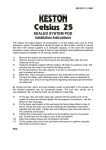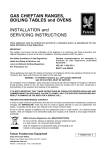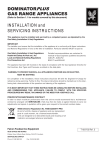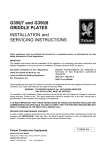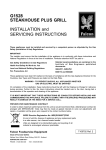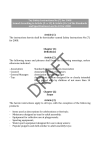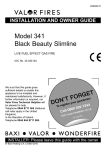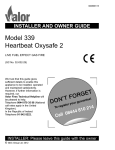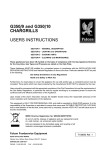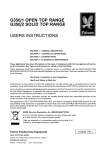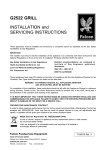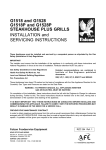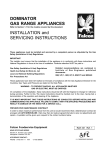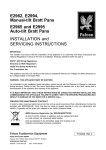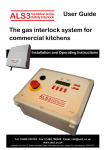Download Falcon 350 Gas Boiling Top Installation Instructions
Transcript
G350/4 and G350/5 BOILING TOPS INSTALLATION and SERVICING INSTRUCTIONS These appliances must be installed and serviced by a competent person as stipulated by the Gas Safety (Installation & Use) Regulations. IMPORTANT The installer must ensure that the installation of the appliance is in conformity with these instructions and National Regulations in force at the time of installation. Particular attention MUST be paid to - Gas Safety (Installation & Use) Regulations Health And Safety At Work etc. Act Local and National Building Regulations Fire Precautions Act Detailed recommendations are contained in Institute of Gas Engineers published documents : IGE/ UP/ 1, IGE/ UP/ 2, BS6173 and BS5440 These Appliances have been CE-marked on the basis of compliance with the Gas Appliance Directive for the Countries, Gas Types and Pressures as stated on the Data Plate. WARNING - TO PREVENT SHOCKS, ALL APPLIANCES, WHETHER GAS OR ELECTRIC, MUST BE EARTHED On completion of the installation, these instructions should be left with the Engineer-in-Charge for reference during servicing. Further to this, The Users Instructions should be handed over to the User, having had a demonstration of the operation and cleaning of the Appliance. IT IS MOST IMPORTANT THAT THESE INSTRUCTIONS BE CONSULTED BEFORE INSTALLING AND COMMISSIONING THIS APPLIANCE. FAILURE TO COMPLY WITH THE SPECIFIED PROCEDURES MAY RESULT IN DAMAGE OR THE NEED FOR A SERVICE CALL. PREVENTATIVE MAINTENANCE CONTRACT In order to obtain maximum performance from this unit we would recommend that a Maintenance Contract be arranged with SERVICELINE. Visits may be made at agreed intervals to carry out adjustments and repairs. A quotation will be given, upon request, to the contact numbers below WEEE Directive Registration No. WEE/DC0059TT/PRO At end of unit life, dispose of appliance and any replacement parts in a safe manner, via a licenced waste handler. Units are designed to be dismantled easily and recycling of all material is encouraged whenever practicable. Falcon Foodservice Equipment HEAD OFFICE AND WORKS Wallace View, Hillfoots Road, Stirling. FK9 5PY. Scotland. SERVICELINE CONTACT PHONE - 01438 363 000 FAX - 01438 369 900 T100689 Ref. 1 SECTION 1 - INSTALLATION UNLESS OTHERWISE STATED, PARTS WHICH HAVE BEEN PROTECTED BY THE MANUFACTURER ARE NOT TO BE ADJUSTED BY THE INSTALLER 1.1 MODEL NUMBERS, NETT WEIGHTS and DIMENSIONS MODEL WIDTH DEPTH mm mm G350/4 350 650 G350/5 700 650 1.2 SITING Recommendations for Ventilation of Catering Appliances are given in BS5440 : 2. Furthermore, to ensure sufficient room ventilation, guidance on the HEIGHT WEIGHT WEIGHT volume of ventilation air required for different types of mm kg lbs catering equipment is provided in the table below. For multiple installations the requirements for individual 305 25.5 56 appliances should be added together. Installation 305 46 101 should be made in accordance with local and/ or national regulations applying at the time. A competent installer MUST be employed. These boiling tops can be installed on a table or counter top, or alternatively on the purpose made metal stand supplied by Falcon. The boiling top units can be installed to within 25mm of a combustible wall at the back and sides, and a clear space of 1000mm should be allowed between the top of the flue outlet and overlying combustible surface. Important If the appliance is to be installed in suite formation with other matching appliances of the Falcon 350 series, the instructions for all units must be consulted to determine the necessary clearances to any combustible rear wall or overlying surface. Some appliances require greater clearance than others, and the largest figure quoted in the individual instructions will determine the clearance for the clearance for the complete suite of adjoining appliances. 1.3 VENTILATION EQUIPMENT Ventilation Rate Required ft3/min m3/ min Range, Unit Type 17 600 Pastry Oven 17 600 Fryer 26 900 Grill 17 600 Steak Grill 26 900 Boiling Pan 17 600 Steamer 17 600 Sterilizing Sink 14 500 Bains Marie 11 400 8.5 - 14 300 - 500 Tea/ Coffee Machine Adequate ventilation, whether natural or mechanical, must be provided to supply sufficient fresh air for combustion and allow easy removal of combustion products which may be harmful to health. 1.4 GAS SUPPLY The incoming services must be of sufficient size to supply full rate without excessive pressure drop. A gas meter is connected to the service pipe by the Gas Supplier. An existing meter should be checked, preferably by the Gas Supplier to ensure that the meter is adequate to deal with the rate of gas supply required. Installation pipework should be fitted in accordance with IGE/UP/2. The size of the pipes from the meter to the appliance must be not less than that of the appliance inlet connection, Rc1/2 (1/2" BSP female). An isolating cock must be located close to the appliance to facilitate shutdown during an emergency or routine servicing. the cock must be easily accessible to the user. 1.5 TOTAL RATED HEAT INPUTS NATURAL and PROPANE GAS Model G350/4 G350/5 kW 9.5 19 Btu/hr 32,400 64,800 1.6 INJECTOR SIZE NATURAL and PROPANE GAS Model G350/4 G350/5 Natural ù 1.8mm ù 1.8mm Propane ù 1.1mm ù 1.1mm 1.7 GAS PRESSURE The following operating pressures apply to both models. mbar inches w.g Natural 15 6 Propane 37 14.8 The pressure test point is sited on the gas manifold behind the front facia panel. An adjustable governor (Rc1/2) is provided for use on NATURAL GAS SUPPLIES ONLY. 1.8 BURNER ADJUSTMENTS The burners are fitted with fixed injectors and aeration settings. NO ADJUSTMENT IS NECESSARY The reduced rate is determined by the size of the bypass screw. These dimensions are as follows NATURAL PROPANE ù mm 0.95 0.6 SECTION 2 - ASSEMBLY & COMMISSIONING 2.3.1 To Light A Burner First identify the appropriate tap by observing the marker on the facia panel. Push the tap inwards, then turn anti-clockwise to the FULL FLAME POSITION whilst applying a lit taper or match to the rim of the burner-head. Hold the control knob in for up to 20 seconds in order for the flame to engage. The tap can be turned further anti-clockwise to reduce the flame if desired. 2.3.2 To Turn The Burner OFF Simply turn the tap clockwise as far as it will go. (see Figure 1) 2.1 ASSEMBLY Place the unit in position and level using feet adjusters. If it is to be mounted on the special purpose stand, refer to the instructions supplied with the stand. Check the open-top burner assemblies: pan supports, spillage deflectors and spillage trays may be packed separately. The spillage tray slides through an aperture in the front panel, beneath the control knobs. The side spillage deflectors have a raised edge which engages under the fixed side trims. The lower burner bodies and injectors of the open top are fixed and should not require adjustment. The upper burner bodies and heads fit loosely on to their bases which protrude through the drip shed. 2.2 CONNECTING TO THE GAS SUPPLY Both models are furnished with a compression elbow fitting, terminating in a Rc1/2 thread for connecting to the mains. The gas supply piping, etc. must be installed in accordance with the various regulations listed on the cover of this manual. On NATURAL GAS installations, the adjustable governor provided MUST BE FITTED in the supply, securely fixed in a position which enables adjustment to be made during commissioning. DO NOT fit governors to appliances burning PROPANE gas. A gas isolating cock must be fitted in the supply, in a position readily accessible to the operator. 2.3 PRE-COMMISSIONING CHECK After connecting to the gas supply, fit a pressure gauge to the pressure test-point (see section 1.7), and check the installation for gas-soundness. Purge air from the system, and light the burners in accordance with the procedures detailed below. With the burners lit, adjust the pressure to the value as detailed in section 1.7. OFF FULL ON (turn anti-clockwise) Figure 1 SIMMER (turn further anticlockwise) 2.4 INSTRUCTION TO USER After installing and commissioning the appliance, please hand the User's Instructions to the user or purchaser and ensure that the person(s) responsible understands the instructions for lighting, cleaning and correct use of the appliance. It is important the ensure that the location of the gas isolating cock is made known to the user, and that the procedure for its operation in an emergency is demonstrated. SECTION 3 - SERVICING & CONVERSION Important BEFORE ATTEMPTING ANY SERVICING, TURN OFF THE ISOLATING COCK AND TAKE STEPS TO ENSURE THAT IT CAN NOT BE INADVERTENTLY TURNED ON. AFTER ANY MAINTENANCE TASK, CHECK THE APPLIANCE TO ENSURE THAT IT PERFORMS CORRECTLY AND CARRY OUT ANY NECESSARY ADJUSTMENTS AS DETAILED IN SECTION 1. After carrying out any servicing or exchange of gas carrying components - ALWAYS CHECK FOR GAS SOUNDNESS! 3.1 GAS CONVERSION CHECK LIST For conversion to NATURAL GAS, add the correct governor and set burner pressure. For conversion to PROPANE GAS, remove the governor from the gas circuit. Other considerations : CHANGE INJECTORS CHANGE BY-PASS SCREW AND SET LOW RATE CHANGE DATA PLATE Also, apply grease to the operating spindle where it enters the plug. 3.2 REMOVAL OF CONTROL PANEL To Remove Pull off all control knobs. Remove the screws holding the panel to the appliance body. Ease the panel down and pull forwards. 3.3 BURNERS Remove the pan supports from the hob. Remove the burner head and top body, together with the drip shed. To remove the lower body of the burner from the respective pipework, undo the injector holder grub screw in the top of the relevant burner neck. Undo the nuts which secure each burner lower body to the support. Remove the support by lifting it clear of the burner bodies. Remove the burner body by pulling it away from the injector holder. Replace in reverse order. 3.4 INJECTORS Remove the pan support and drip shed as detailed in Section 3.3. Undo the injector from the respective holder using a 14mm ring spanner. Ensure that the injector remains in a steady position. Replace in reverse order. 3.5 FLAME FAILURE THERMOCOUPLE/ELECTRODE Remove the pan support and drip shed as detailed in Section 3.3. Undo the thermocouple connection at the FFD section of the gas tap. Undo the top nut which secures the thermocouple to the burner support. Pull the thermocouple through the support underside. Replace in reverse order. 3.6 GAS TAPS Remove the control panel as detailed in Section 3.2. To Service Remove the two screws from the front of the tap body and withdraw the spindle and niting arrangement thus allowing the plug to be eased out. Replace in reverse order. Clean all parts with a soft rag, and sparingly re-grease the plug with an approved high temperature grease. Note Tap plugs and bodies are made in MATCHED pairs, DO NOT INTERCHANGE. Undo the compression fitting nut on the gas supply pipe at the gas tap rear. Remove the thermocouple connection from the FFD section of the tap. Undo two screws and gently remove the tap from the supply manifold. Before refitting the tap to the float rail, check the serviceability of the rubber sealing washer. If in doubt, fit a new washer. Replace in reverse order and check for gas soundness. 3.7 GOVERNOR This applies to NATURAL GAS UNITS ONLY. The type of governor used will normally require little servicing. The air breather hole should be checked for dirt blockage. Always re-check the pressure at the test point after governor maintenance. SECTION 4 - SPARES When ordering spare parts, always quote the unit type and serial number. This information can be found on the data plate located to the oven base plate. On boiling table models, the data plate is located on a swing plate at the rear RH side. A list of available parts can be found in the accompanying spares section of this document pack.




